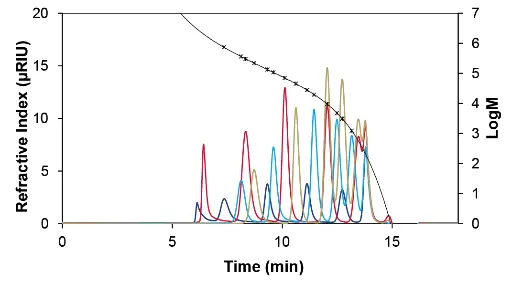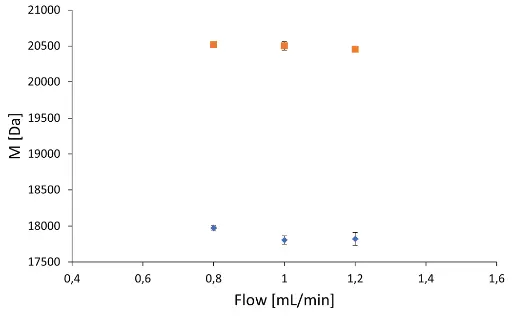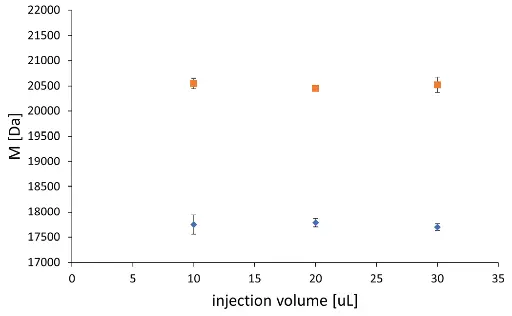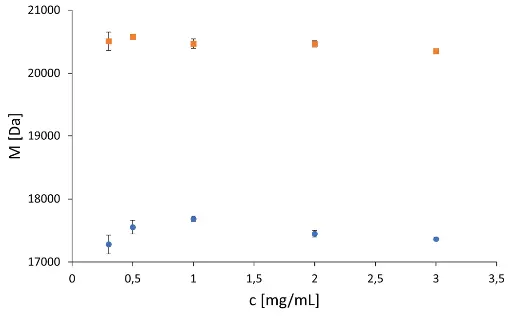
Science with Passion
Application No.: VEV0087
Version 1 11/2021
Determining molecular weights for P(D,L)LA in THF – an internal validation
Nils Lüttgert, Lisa Loxterkamp, Juliane Böttcher, Kate Monks; applications@knauer.net
KNAUER Wissenschaftliche Geräte GmbH, Hegauer Weg 38, 14163 Berlin

Photo: Freepik.com
Summary
A method was validated intralaboratory to analyse low molecular weight P(D,L)LA in tetrahydrofuran (THF) with respect to the number average molar mass (Mn) and weight average molar mass (Mw). For this purpose, a KNAUER HPLC system was used in combination with a linear GPC column. The obtained molar masses were compared with the values of the absolute methods and any deviations were discussed. The method was validated with respect to its repeatability and robustness to changes in flow rate, temperature, injection volume and sample concentration.
Introduction
Plastics are one of the most widely used and most versatile materials of the 21st century. However, the majority of the world’s annual production of approximately 370 million tons of plastics is neither biodegradable nor produced from renewable raw materials.(1) In contrast, poly lactic acid (PLA) is a promising plastic that has sustainable properties. The physical properties of plastics are mostly determined by their molar mass distribution, with the parameters Mn, Mw and the PD being the most important. GPC is the method of choice for the determination of these parameters. When no absolute method is available, the two most frequently used calibrations are conventional and universal calibration. For the conventional calibration, calibration standards of the polymer to be analysed are required or, at the very least, standards of a chemically similar plastic are required. For universal calibration, first published by Benoit(2), a universal calibration curve is created using the Mark-Houwink relationship, so that a wide variety of polymers can be analysed, for example with a narrow polystyrene (PS) calibration. In 1998, S. Mori published the results of a multistage round-robin test in which PS standards were analysed by GPC using conventional calibration (CC) with PS under various framework conditions.(3) The relative interlaboratory standard deviation (%RSD) for Mn of more than 20 % was reduced by setting strict framework conditions for the analysis, such as the injection volume, sample concentration, and sample size.
This shows that certain standards must be adhered to obtain reliable values by means of GPC. Therefore, a method has been provided in this publication to analyse lower molecular weight P(D,L)LA using universal calibration. The method was developed according to ISO 13885-1 and its robustness and accuracy were investigated intralaboratory.(4)
Sample Preparation
For calibration with PS, an EasiCal-Kit in the molar mass range 580 Da – 6 570 kDa from Agilent was used (20 standards). The calibration standards were dissolved in 1 ml THF for one hour and then mixed with butylated hydroxytoluene (BHT) as a flow marker to a concentration of 1.5 mg/ml. For all samples, approximately 20 mg were weighed out and dissolved overnight (o.n.) in THF to a concentration of 3 mg/ml. The following day, the samples were diluted to 1 ml with THF and the flow marker BHT was added (1.5 mg/ml). All experiments were carried out by the same operator.
Results and Discussion
Initially, a calibration was made using PS. The two largest and lowest molar masses were excluded due to their peak shape and overlap with the flow marker. Additionally, two standards had the same molar mass, resulting in a 14-point universal calibration with a 5th degree fit function (1 230 Da – 729 500 Da). The overlay of the calibration function and the chromatograms is shown in Fig. 1. For universal calibration with PS in THF, the following Mark-Houwink parameters were used:

Fig. 1 14-point PS universal calibration in THF by Agilent (EasiCal). Blue = EasiCal-1-A; red = EasiCal-1-B; light blue = EasiCal-2-A; gold = EasiCal-2-B. Fit function of the 5th degree with deviations less than 5 %. R2=0.9999.
Accuracy
Tab. 1 shows the molar masses determined using CC and UC. The comparison with the values of the absolute method via 1H-NMR shows that the universal calibration provides much more accurate values. The values for Mn and Mw were taken from the certificate, with Mn determined by 1H-NMR. The method used to determine the Mw value was not specified. The comparison of the molar masses determined with CC versus determination with absolute methods has shown that CC has large deviations of more than 40 %. In contrast, UC showed good results with a deviation of 3 % for Mn and 1 % for Mw. Round robin tests have shown that GPC-based methods in the simplest case of polystyrene in THF using CC have a high uncertainty in their reproducibility (interlaboratory) of 13–16 % for Mn and 6–10 % for Mw.(3) For more complex polymers, deviations can also be larger.(7) There is a tendency for the Mn value to show greater uncertainty than the Mw value.
Tab. 1 Comparison of the determined molar masses using PS UC and CC with the molar masses determined by 1H-NMR. *Average of 6-fold determination with (%)-deviation respective to the standard.
PLA standard (Mx) (Da) | UC average (Da) | UC values (Da) | CC average (Da) | CC values (Da) |
Mn: 17 286 (by 1HNMR) | 17 854* (+3 %) | 17 770 | 24 879* (+44 %) | 24 703 |
17 939 | 25 064 | |||
17 849 | 24 796 | |||
17 957 | 25 052 | |||
17 805 | 24 831 | |||
17 801 | 24 825 | |||
Mw: 20 700 (certificate) | 20 951* (+1 %) | 20 927 | 29 268* (+41 %) | 29066 |
20 984 | 29250 | |||
21 008 | 29096 | |||
20 958 | 29441 | |||
20 905 | 29366 | |||
20 922 | 29391 |
Repeatability and intermediate precision
To test repeatability, 6 injections of a 1 mg/ml concentrated PLA solution were injected consecutively. The relative standard deviation was determined to be ± 82 Da (0.43 %RSD) for Mn and ± 42 Da (0.19 %RSD) for Mw. Furthermore, the intermediate precision was tested. For this purpose, the sample preparation was repeated on three consecutive days and a triple determination was performed in each case. The relative standard deviation was ± 105 Da (0.59 %RSD) for Mn and ± 111 Da (0.54 %RSD) for Mw. Both values meet the requirements of ISO 13885-1, which specifies values lower than 3 % for Mn and 2 % for Mw.
Robustness
Several parameters of the method were varied to investigate their influence on the result of the molar mass determination and to determine the respective standard deviation. First, the temperature was changed by ± 2 °C. Fig. 2 shows that the method is robust for a change of ± 2 °C as Mn and Mw do not change significantly and do not show a trend. The standard deviations were between 16- and 137 Da (<0.8 %RSD).

Fig. 2 Mn (dots) and Mw (squares) values at 23-, 25-, and 27 °C. Triple determination with relative standard deviation. 1 mg/ml, 20 µl injection volume.
The flow rate was changed by ±0.2 ml/min. Fig. 3 shows that the method is robust even when the flow rate is changed by ±0.2 ml/min as the %RSD is low and no trend can be detected. The flow marker shows its strength here, as Mn and Mw are also very stable in this experiment when applying flow correction.

Fig. 3 Mn (dots) and Mw (squares) values at 0.8-, 1.0-, and 1.2 ml/min. Triple determination with relative standard deviation. 1 mg/ml, 20 µl injection volume.
For all experiments, 20 µl of PLA sample were injected. The aim was to investigate the influence of the injection volume on the molar mass determination. Fig. 4 shows the result. There is no significant effect on the molar mass determination in the range 10–30 µl injection volume. The %RSD is low and no trend can be identified.

Fig. 4 Mn (dots) and Mw (squares) values at 10-, 20-, and 30 µL injection volume. Triple determination with relative standard deviation. 1 mg/ml.
When determining high molar masses, concentration effects can reduce the hydrodynamic volume so that the molar mass is underestimated. This is the reason why ISO 16014-3 specifies a sample concentration of 0.5 mg/ml for polymers with a molar mass that exceeds an order of magnitude 106 Da, while sample concentrations of up to 5 mg/ml are not a problem for samples with a Mw less than 105 Da. Since the used PLA standard for validation is in the magnitude of 104 Da, no concentration effects should occur at an injection concentration of 1 mg/ml. As an indication for these effects, the molar mass would have to increase with decreasing sample concentration. To test this, Mw and Mn were determined for different concentrations in the range 0.1–3 mg/ml. The results in Fig. 5 show that there is no trend towards higher molar masses at lower concentrations, so that the method can be considered robust in the concentration range 0.3- to 3 mg/ml. Below 0.3 mg/ml the S/N was smaller than 20. In ISO 16014-1 a S/N > 20 is recommended so these values were not considered.(8)
Conclusion
The investigations have shown that the determination of the Mn and Mw of low molecular weight P(D,L)LA is easily possible using a KNAUER HPLC system combined with a gel permeation chromatography (GPC)-column. The intralaboratory validation in THF proves that the developed method is robust within the limits shown here with respect to changes in temperature, concentration, flow rate and injection volume. Furthermore, the repeatability of the molar mass determination as well as the intermediate precision of the sample preparation was verified. It was shown that the CC fails for this column/solvent/polymer combination, whereas the UC provides good results. The conventional calibration fails because the different hydrodynamic radii of PLA and PS in THF are not taken into account. The flow rate has a very strong influence on the molar mass determination and must be as constant as possible. Slight fluctuations affect the retention volume. In order to take fluctuations into account, a flow marker, in this case BHT, was used and is recommend as mandatory for all GPC/SEC applications.

Fig. 5 Mn (dots) and Mw (squares) values at 0.3-, 0.5-, 1.0-, 2.0-, and 3.0 mg/ml sample concentration. Triple determination with relative standard deviation. 20 µl injection volume.
Materials and Methods
Standards, Eluents and Samples
Chemical | CAS | Purity | Manufacturer |
P(D,L)LA | 26780-50-7 (Batch: MKCL3830) | not specified | Sigma-Aldrich |
BHT | 128-37-0 | ≥ 95 % | Supelco |
THF | 109-99-9 | ≥ 99.8 % | Supelco |
PS-CAL-Kit | (Batch: 6374186/6381821) | not specified | Agilent |
Method parameters | |
Column temperature | 25 °C |
Injection volume | 20 µl |
Injection mode | Partial Loop |
Detection | RID |
Data rate | 10 Hz |
Pump parameters | |
Eluent (A) | THF |
Flow rate | 1 ml/min |
Pump program | isocratic |
System configuration
Instrument | Description | Article No. |
Pump | AZURA P6.1L HPG | |
Autosampler | AZURA AS 6.1L | |
Detector | AZURA RID 2.1L | |
Thermostat | AZURA CT 2.1 | |
Pre-Column | AppliChrom ABOA StyDiViBe 10E5A-BPT,500–1.5 MioDa, 50x8 mm, 100.000 A | |
Column | AppliChrom ABOA StyDiViBe 10E5A-BPT,500–1.5 MioDa, 300x8 mm, 100.000 A | |
Software | ClarityChrom 8.5 – Workstation, autosampler control included | |
Software | ClarityChrom 8.2.3 – SEC/GPC extension |

References
[1] https://de.statista.com/statistik/daten/studie/167099/umfrage/weltproduktion-von-kunststoff-seit-1950/. Stand: 2019. Abgerufen 25.08.2021, 14:08 Uhr.
[2] Benoit, F., Grubisic, Z., Rempp, P.: Journal of Polymer Science 1967, B, 5, 753.
[3] S. Mori, International Journal of Polymer Analysis and Characterization: 1998, 4, 6, 531-546.
[4] ISO 13885-1: Gel permeation chromatography (GPC) – Part 1: Tetrahydrofuran as eluent, 2020.
[5] Polymer handbook: Third edition Edited by J. Brandrup and E. H. Immergut, Wiley-Interscience, Chichester, 1989, VII-46.
[6] J. Dorgan, J. Janzen, D. Knauss, B. Hait, R. Limoges, M. Hutchinson: J. Polym. Sci. B Polym. Phys., 2005, 43, 3100-3111.
[7] R. Bruessau, Macromol. Symp.: 1996, 110, 15-32.
[8] ISO 16014-1: Plastics – Determination of average molecular weight and molecular weight distribution of polymers using size-exclusion chromatography- Part 1: General principles.
Related KNAUER Applications
VCH0017 – Molecular weight distribution of a broad polystyrene standard
VEV0084 – Analysis of Poly [(R)-3-hydroxybutyric acid] in chloroform using GPC and universal calibration
VEV0085 – Size exclusion chromatography of polylactide acid in three different solvents
VEV0086 – Determining molecular weights for P(D,L)LA in ethyl acetate – an internal validation
– Green SEC/GPC – comparison of two calibrations in three different solvents
Application details
Method | HPLC |
Mode | RP |
Substances | EPA 610 PAH mixture, fluoranthene, benzo[b]fluoranthene, benzo[k]fluoranthene, benzo[a]pyrene, benzo[g,h,i]perylene, indeno[1,2,3-cd]pyrene |
CAS number | 206-44-0, 205-99-2, 207-08-9, 50-32-8, 191-24-2, 193-39-5 |
Version | Application No.: VEV0087 | Version 1 11/2021 | ©KNAUER Wissenschaftliche Geräte GmbH |


